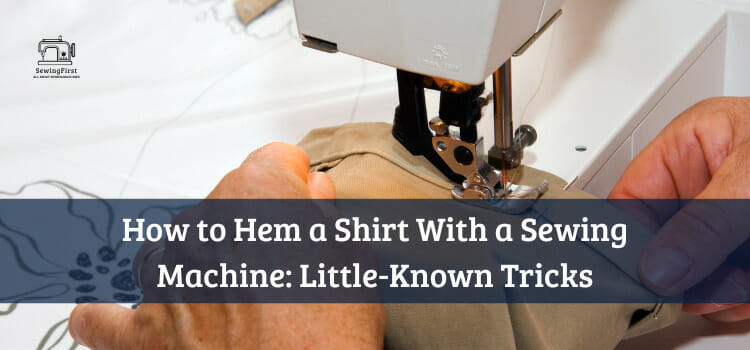Hemming a shirt can be like an intricate dance between you and your sewing machine; one false move and the whole thing could unravel. You are the choreographer, your fabric is the partner – if you follow these steps closely, then together you’ll create something beautiful that will last for years to come!
Do you want to learn how to hem a shirt with a sewing machine but don’t know where to start? Whether it’s learning new stitches, threading needles, or simply understanding how machines work – we’ve all been there at some point in our lives. Well, look no further because with this article, mastering the art of hemming has never been easier.
We’ll take you through each step, from choosing fabrics and threads right up to stitching those perfect hems on any type of clothing item. With clear instructions and photographs along the way, soon enough you’ll have made your own pieces of custom clothing without ever leaving home! So let’s get started.
Related Topic: How to Shorten Straps on a Dress Without Sewing Machine
Table of Contents
ToggleGathering Supplies Needed To Hem A Shirt
For anyone wanting to master the art of hemming a shirt, look no further! Gearing up with some basic sewing supplies is like sharpening your sword for battle.
Sewing machines, fabric scissors, and sewing pins are crucial for any successful task; these will be our trusty sidekicks in this endeavor.
Let’s start by understanding the basics of hems and the different types of hemming methods that can be used when tackling a project. A presser foot can help you create neat hems on thin fabrics such as chiffon or organza while blind stitches are ideal for heavier fabrics.
Furthermore, a rolled hemmer foot creates an elegant edge on delicate materials. It’s important to note that choosing the right type of stitch also depends on the fabric being used.
Now comes putting it all together: time to get creative! Choose one of the many techniques available depending upon what kind of look you’re going for – from single-folded edges to double-stitched ones – and begin stitching away at your masterpiece!
With the supplies we’ve discussed here today, there should be nothing stopping you from achieving stunning results every time.
Understanding The Different Types Of Hem
Hemming a shirt is an art form. It’s a skill that requires precision and patience, but the end result can be rewarding when done well. Understanding the different types of hems available for use on a sewing machine is essential to achieving success.
The first type of hem involves hemming knits with single-needle stitching. This process uses one thread in the bobbin area to create strong stitches while working with stretchy material.
The second type of hem uses double-needle stitching which creates two parallel rows of straight stitches along the edge of the fabric to provide additional strength and stability.
Finally, there are rolled or blind hems that involve folding over multiple layers of fabric before pressing them into place with an iron or steam presser.
No matter what kind of hem you choose, it’s important to understand the basics of each so that you can properly execute your project without any issues. Hemming knits require extra care due to their stretchy nature, whereas more rigid fabrics may need less caution during the hemming process.
Double needles give projects added durability and visual appeal compared to using just a single needle for your edges. Lastly, rolled or blind hems offer an even cleaner finish than standard flat-stitched options, making them great choices for more formal garments like dress shirts and blouses. With these key points in mind, you’ll be ready to mark your desired hem line and begin creating beautiful garments!
Marking The Desired Hem Line
Ready to get started on your sewing project? Great! Before you can begin, there is an important step that will help make sure your shirt has the perfect hem: marking the desired hem line. This may sound daunting but with a few tools and some careful attention, it’s easy enough for any level of sewer.
First things first – take a look at the raw edge of the fabric before you start to sew. If the edges are frayed or uneven, trim them off so they have a nice clean cut. Then measure out how long you want your new shorter shirt to be relative to its existing length.
Use a ruler and tailor’s chalk (or another type of marker) to draw a straight line along this measurement all around the bottom of the shirt – this will be your ideal hemline. Ensure that both sides match up in terms of length by double-checking against each other regularly as you go along.
Now just consider what style of shirt you want and select thread colors accordingly; if possible choose ones that blend in well with whatever color palette you’re working with. With these steps completed, you’re ready to move on to setting up your sewing machine.
Setting Up The Sewing Machine
Setting up the sewing machine is like preparing for a battle. It’s important to ensure that you have all the right tools, and know exactly how to use them. To hem a shirt with a sewing machine, it’s essential to equip yourself with twin needles, fabric stabilizer, and walking foot attachment, and adjust your stitch tension accordingly.
Before beginning the project, make sure that the needle plate of your sewing machine has been set to straight stitching rather than zigzag; this will help keep your stitches even. While setting up your machine, consider using a thread size slightly thicker than usual as this will give more body and strength to each stitch.
A walking foot can also be helpful in creating an evenly sewn seam when hemming a shirt; as its name suggests, these attachments are designed to ‘walk’ across multiple layers of fabric simultaneously providing extra stability throughout the process.
Lastly, if working on heavier fabrics such as denim or canvas, applying fusible interfacing or some type of fabric stabilizer may help maintain accuracy while sewing.
Now that everything is prepared and ready to go, let’s move on to marking our desired hemline!
How To Hem A Shirt With A Sewing Machine: Step By Step Guide
If you’re looking to give your t-shirts a professional, finished appearance then hemming them is an easy and effective way to do just that. Hemming is not only a great way to customize the length of any shirt but also helps keep its shape of it intact – no one likes a shapeless wardrobe!
With this step-by-step guide, you’ll be able to transform your everyday t-shirt into something special in no time at all.
- First thing first – before you start hemming your shirt, make sure you’ve got enough seam allowance so as to avoid making any unwanted holes or rips.
- Set up your sewing machine for straight stitches and adjust accordingly depending on the fabric type and shirt color.
- Once everything’s set, begin stitching around the bottom part of the shirt following its original hem line until you reach where the new hem will end.
- Once you have secured the thread with a few backstitches, switch over to the zigzag or stretch stitch setting if available and finish off with some stitches along both sides of the existing seamline while keeping close attention to the exact alignment between both ends.
Make sure not to forget about reinforcing those side seams either; This will ensure that they stay secure even after multiple washes.
Now that we’ve created our new hem line, let’s move on to taking care of other details and finishing touches necessary for completing our project successfully.
Hemming A T-Shirt Using The Original Hem
Hemming a t-shirt is an art form that requires skill and finesse. To properly execute the perfect hem requires one to be knowledgeable in their technique and materials. Let’s take a look at how you can use your regular sewing machine to achieve success with this task!
When using the original hem of a t-shirt to create your design, make sure that your fabric is flat on a surface before beginning. This will help ensure accuracy when stitching and also prevent puckering or pulling of the fabric while working.
Use a differential feed setting if available on your machine as it helps reduce stretching in more stretchy fabrics. Here are five tips for achieving a great finish:
- Adjust tension settings according to the type of material being used.
- Make sure both threads (bobbin thread and top thread) have even amounts of tension applied for best results. • Slow down when turning corners to prevent puckers from forming in the fabric.
- Reduce pressure foot pressure as needed depending on the thickness of the material being worked with.
- Secure stitches by backstitching at start/end points to keep seams secure over time.
An experienced sewer knows that mastering these techniques takes practice, but following them carefully will yield beautiful results each time!
With patience and dedication, anyone can learn how to professionally hem any kind of garment – whether it’s a t-shirt or something else entirely! Now let’s shift our focus toward hemming button-up shirts using bias tape.
Hemming A Button-Up Shirt Using Bias Tape
Hemming a button-up shirt can feel like threading the eye of a needle, but with some patience and the right tools you’ll be able to create an impressively finished edge. Achieving this look is easy if you follow these steps:
- Gather your tools – a seam ripper, a loop of thread, and bias tape.
- Mark where you want to start hemming using pencil skirts or any other marker that won’t come off in the water.
- Attach your bias tape along the line and sew it on.
Using bias tape for hemming gives you a professional finish without having to worry about fraying fabric edges. When attaching the bias tape, make sure to use small stitches so that it doesn’t get pulled out over time when washing and wearing clothes.
If at any point during this process, you’re feeling overwhelmed, just take a break and come back fresh! Hemming with bias tape isn’t hard once you know how; all it takes is practice and dedication to perfect the technique. With a little bit of effort, soon enough those buttons will have beautiful hems flowing around them – ready for wear!
Shortening T-Shirts
Shortening a t-shirt is a fun and easy project, especially when you have the right tools. You’ll need your sewing machine, some thread to match the color of your shirt, as well as scissors for cutting away excess fabric.
If you don’t own a cover stitch or serger machine, then you should look into using a blind stitch on the curved edges—it’s an effective way to hem most woven fabrics without leaving loose threads behind.
Before getting started with the project, try on your shirt and mark where it needs to be shortened by pinning along that line. Once finished, go ahead and cut off any extra material from around the bottom hemline before beginning to sew—this will help ensure everything looks even once completed.
Now it’s time to get your needle ready! Choose either straight or zigzag stitches depending on what kind of finish you’re hoping to achieve; both are effective ways of creating neat hems in t-shirts but keep in mind that certain machines may offer more options than others.
For example, if you have access to a cover stitch machine then this can provide excellent results while still being relatively simple to use.
By following these steps closely and taking good care of all materials used throughout the process, shortening a t-shirt doesn’t have to be intimidating anymore—you can create professional-looking garments at home with ease! The next step is learning how to do basic Hemming for beginners so that anyone can craft their perfect garment quickly and easily.
Hemming A Shirt For Beginners
Hemming a shirt for beginners is the perfect way to take your wardrobe from drab to fab! Whether you’re looking to shorten a t-shirt or add a professional touch, here are four easy steps to make it happen.
First off, gather all of your materials. You’ll need your sewing machine with its feed dogs engaged and ready as well as scissors, thread, pins, an iron, and excess fabric.
Once everything is in place, begin by cutting away any excess fabric that hangs below your desired hem length. Then press down each layer of fabric using the iron – this will help keep them together when you move on to the next step.
When you’re ready, start feeding the layers of fabric through the machine while making sure they stay aligned throughout the process. Pay special attention if you’re working with stretch fabrics or delicate fabrics since these require extra care.
To ensure that your project looks neat and finished on both sides, repeat this same process on the backside of the garment before moving on.
Finally, cut away any loose threads that remain, and voilà! You’ve just successfully given a plain old shirt an upgrade without breaking into a sweat – time to show off your new skills!
Sewing The Hem Of A T-Shirt Professionally
Bringing your t-shirt to a professional level isn’t as daunting as it may seem. With just the right bit of fabric and some patience, you can take that extra bit of fabric from cumbersome to chic in no time.
Creating a neat hem on your shirt using a sewing machine is an art form all its own! By taking the proper steps, you will be able to achieve a polished finish without much effort – perfect for any wardrobe makeover or repair project.
To begin, fold up your extra fabric so that there’s about one centimeter between the edge of the fabric and the seam allowance line of your t-shirt. Secure this with pins before feeding it into your sewing machine, making sure each stitch is even and straight. If done correctly, this should create a crisp edge along the bottom of your shirt which looks like it was professionally made!
Remember: practice makes perfect when tackling projects like these – don’t be afraid to try again if it doesn’t work out perfectly at first. Once complete, admire your handiwork knowing you have achieved a professional finish!
Shirt Too Long Hack
Hemming a shirt that’s too long doesn’t have to be difficult. With the right tools and knowledge, you can create professional-looking results quickly and easily. This hack is perfect for t-shirts with excess length or any other type of top that needs to be hemmed.
To get started, find an area on the shirt from which to measure. Mark it off using chalk or pen so you’ll know exactly how much fabric to remove. Then thread your sewing machine and make sure all settings are correct before beginning.
Once everything is ready, start stitching along the marked line until you reach the end of the fabric. Cut away any frayed edges and iron out creases if necessary.
Now that you’ve successfully shortened your t-shirt, take a moment to admire your hard work! Thanks to this easy trick, you can now transform tops that were once ill-fitting into stylish garments without wasting time at a tailor shop – giving you more freedom than ever before to express yourself through fashion.
Cost To Hem A Shirt
“A stitch in time saves nine.” As the saying goes, it pays to invest a little bit of effort and resources into hemming a shirt. Hemming can be done with or without sewing machines, but for those who want a professional finish that lasts longer, going through the extra step of using a machine is worth its weight in gold. Here are some of the cost considerations when hemming a shirt:
- Professional Tailor – If you’re looking for convenience and ease of use then look no further than hiring an experienced tailor. The cost depends on where you live as well as how much fabric needs to be altered.
- Thread & Needles – For DIYers out there this option might be perfect; all you need are needles, thread, scissors, and your own two hands! Depending on the size of your project, buying supplies could add up quickly so plan ahead if this route is chosen.
- Sewing Machine – Investing in one or even renting/borrowing one could save money over several projects. A quality machine will last years when properly maintained and used correctly.
Beyond just costs consider also the amount of time spent hemming shirts by hand versus machine; while both can get the job done they have different levels of speed and accuracy associated with them.
Taking these factors into account helps determine which method works best for each individual situation. With all that said, let’s turn our attention to tackling stretchy fabrics…
Hemming Stretchy Fabrics
When you’re ready to hem a shirt with a sewing machine, there’s one important factor that can make or break the outcome: stretchy fabrics. Knowing how to handle this type of fabric is key to getting that perfect hem.
Stretchy fabrics like knits and spandex require special care when it comes to hemming. If you don’t take the time to do it right, your hems will end up being wavy instead of straight. Plus, if you don’t allow enough room in the seams, they’ll be too tight around the curves and could unravel over time.
The trick here is to use smaller stitches than usual and stay at least 1/4 inch away from any edges when stitching so that your seam allowances won’t get pulled out of shape as your garment wears and stretches.
With practice, patience, and attention to detail, you’ll find yourself creating beautiful hems on all kinds of stretchy materials! Transitioning into different types of hemming techniques and tips gives us more options for customizing our garments – let’s dive in!
Different Types Of Hemming Techniques And Tips
Hemming your shirt can be a daunting task – but it doesn’t have to be! There are several different types of hemming techniques and tips available for you to use when sewing with a machine. With the right knowledge, anyone can master the art of hemming.
Straight Hems
Straight hems involve simply folding up the edge of the fabric, ironing it in place, and stitching from the inside of the garment along this fold line. This type of hem is great if you’re looking for something simple and clean-looking.
For a more sophisticated finish, double-folded hems may be used instead; just make sure that you use enough pins or clips to keep everything in place before stitching!
Decorative Hems
Decorative hems add an extra bit of flair to any outfit by using ruffles or lace trim on the bottom edge of the garment. To create these kinds of hems, start by measuring out how much trim will go around each side:
- Make sure not to stretch it too tightly as this could cause puckering.
- Pin it into place on top of your folded-over fabric before sewing together with a zigzag stitch pattern that ensures maximum durability.
- Don’t forget about blind hems
they offer a neat finish without being visible from the outside! Hem tape can also be used here to give extra support if needed.
Whether you want something quick and easy or something more intricate and eye-catching, there’s definitely a hem style out there for everyone! With practice and patience, even beginners can learn how to sew perfect hems every time – no matter what their project requires. So get creative and enjoy exploring all your options today!
Conclusion
Hemming a shirt with a sewing machine is not as daunting as it seems. Once you understand the basics and gather the necessary supplies, you can create professional-looking hems for all your garments. With some patience, practice, and perseverance, anyone can learn how to hem their own clothes.
By gaining a basic knowledge of different types of hems, setting up your sewing machine correctly, and following step-by-step instructions through the process, you’ll soon be mastering this skill in no time!
Finally, remember that having control over your clothing means I’m able to save money while also creating custom pieces tailored just for me! Hemming my own clothing has been an incredibly rewarding experience and one I highly recommend trying out yourself.
FAQs
What stitch is used to hem shirts?
The most common stitch used to hem shirts is a straight stitch.
What machine stitch is best for hemming?
The best stitch for hemming is a narrow zigzag stitch. This type of stitch is very strong and provides a secure hem that won’t come undone easily. It is also very versatile, as it can be used on a variety of fabrics.
Can sewing machine be used for hemming?
Yes, a sewing machine can be used for hemming. Hemming is a type of sewing technique used to finish the edges of the fabric. It involves folding the edge of the fabric over and securing it in place with stitches.
What are 2 different ways to sew a hem?
1. Machine Stitching: This is the most common way to hem fabric. It involves folding the edge of the fabric over, pressing it in place, and then stitching along the fold with a sewing machine.
2. Hand Stitching: This is an older method of hemming and involves folding the edge of the fabric over, pressing it in place, and then stitching along the fold with a needle and thread.
How do you hem a shirt at home?
1. Begin by folding the shirt fabric up to the desired length. Use pins to hold the fold in place.
2. Start sewing the hem, using a straight stitch. Start at the side seam and sew along the edge of the folded fabric.
3. Continue sewing until you reach the end of the hem.
4. Remove the pins and trim any excess fabric.
5. Finish the hem by pressing it with an iron.
What length of stitch for hems?
The recommended stitch length for hems is 2.5-3mm.
How do you sew a hem without it showing?
The best way to sew a hem without it showing is to use a blind hem stitch. This stitch is created by hand or machine and uses small stitches that are not visible from the right side of the fabric. To do a blind hem stitch by hand, fold the fabric along the hem line and then use a needle and thread to make small stitches, catching only a few threads of the fold.





